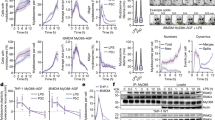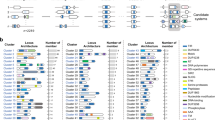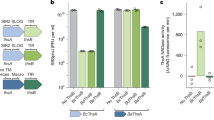Abstract
Pathogenic microbes have evolved sophisticated molecular strategies to subvert host defenses. Here we show that virulent bacteria interfere directly with Toll-like receptor (TLR) function by secreting inhibitory homologs of the Toll/interleukin-1 receptor (TIR) domain. Genes encoding TIR domain containing–proteins (Tcps) were identified in Escherichia coli CFT073 (TcpC) and Brucella melitensis (TcpB). We found that TcpC is common in the most virulent uropathogenic E. coli strains and promotes bacterial survival and kidney pathology in vivo. In silico analysis predicted significant tertiary structure homology to the TIR domain of human TLR1, and we show that the Tcps impede TLR signaling through the myeloid differentiation factor 88 (MyD88) adaptor protein, owing to direct binding of Tcps to MyD88. Tcps represent a new class of virulence factors that act by inhibiting TLR- and MyD88-specific signaling, thus suppressing innate immunity and increasing virulence.
This is a preview of subscription content, access via your institution
Access options
Subscribe to this journal
Receive 12 print issues and online access
$259.00 per year
only $21.58 per issue
Buy this article
- Purchase on SpringerLink
- Instant access to full article PDF
Prices may be subject to local taxes which are calculated during checkout






Similar content being viewed by others
References
Iwasaki, A. & Medzhitov, R. Toll-like receptor control of the adaptive immune responses. Nat. Immunol. 5, 987–995 (2004).
Akira, S., Uematsu, S. & Takeuchi, O. Pathogen recognition and innate immunity. Cell 124, 783–801 (2006).
Svanborg, C. et al. Uropathogenic Escherichia coli as a model of host-parasite interaction. Curr. Opin. Microbiol. 9, 33–39 (2006).
Takeuchi, O., Hoshino, K. & Akira, S. Cutting edge: TLR2-deficient and MyD88-deficient mice are highly susceptible to staphylococcus aureus infection. J. Immunol. 165, 5392–5396 (2000).
Abel, B. et al. Toll-like receptor 4 expression is required to control chronic Mycobacterium tuberculosis infection in mice. J. Immunol. 169, 3155–3162 (2002).
Torres, D. et al. Toll-like receptor 2 is required for optimal control of Listeria monocytogenes infection. Infect. Immun. 72, 2131–2139 (2004).
Rodriguez, N. et al. Differential involvement of TLR2 and TLR4 in host survival during pulmonary infection with Chlamydia pneumoniae. Eur. J. Immunol. 36, 1145–1155 (2006).
Poltorak, A. et al. Defective LPS signaling in C3H/HeJ and C57BL/10ScCr mice: mutations in Tlr4 gene. Science 282, 2085–2088 (1998).
Kawai, T. & Akira, S. TLR signaling. Cell Death Differ. 13, 816–825 (2006).
Burns, K. et al. Inhibition of interleukin 1 receptor/Toll-like receptor signaling through the alternatively spliced, short form of MyD88 is due to its failure to recruit IRAK-4. J. Exp. Med. 197, 263–268 (2003).
Bowie, A. et al. A46R and A52R from vaccinia virus are antagonists of host IL-1 and Toll-like receptor signaling. Proc. Natl. Acad. Sci. USA 97, 10162–10167 (2000).
Harte, M.T. et al. The poxvirus protein A52R targets Toll-like receptor signaling complexes to suppress host defense. J. Exp. Med. 197, 343–351 (2003).
Stack, J. et al. Vaccinia virus protein A46R targets multiple Toll-like–interleukin-1 receptor adaptors and contributes to virulence. J. Exp. Med. 201, 1007–1018 (2005).
Newman, R.M., Salunkhe, P., Godzik, A. & Reed, J.C. Identification and characterization of a novel bacterial virulence factor that shares homology with mammalian Toll/interleukin-1 receptor family proteins. Infect. Immun. 74, 594–601 (2006).
Radons, J. et al. The interleukin 1 (IL-1) receptor accessory protein Toll/IL-1 receptor domain: analysis of putative interaction sites in vitro mutagenesis and molecular modeling. J. Biol. Chem. 278, 49145–49153 (2003).
Costa, C.P. et al. Role of chlamydial heat shock protein 60 in the stimulation of innate immune cells by Chlamydia pneumoniae. Eur. J. Immunol. 32, 2460–2470 (2002).
Lafont, F. & van der Goot, F.G. Bacterial invasion via lipid rafts. Cell. Microbiol. 7, 613–620 (2005).
Pannek, S. et al. Multidrug efflux inhibition in Acinetobacter baumannii: comparison between 1-(1-naphthylmethyl)-piperazine and phenyl-arginine-β-naphthylamide. J. Antimicrob. Chemother. 57, 970–974 (2006).
Frendeus, B. et al. Escherichia coli P fimbriae utilize the Toll-like receptor 4 pathway for cell activation. Mol. Microbiol. 40, 37–51 (2001).
Samuelsson, P., Hang, L., Wullt, B., Irjala, H. & Svanborg, C. Toll-like receptor 4 expression and cytokine responses in the human urinary tract mucosa. Infect. Immun. 72, 3179–3186 (2004).
Gorvel, J.P. & Moreno, E. Brucella intracellular life: from invasion to intracellular replication. Vet. Microbiol. 90, 281–297 (2002).
Delrue, R.M. et al. Identification of Brucella spp. genes involved in intracellular trafficking. Cell. Microbiol. 3, 487–497 (2001).
Comerci, D.J., Martinez-Lorenzo, M.J., Sieira, R., Gorvel, J.P. & Ugalde, R.A. Essential role of the VirB machinery in the maturation of the Brucella abortus–containing vacuole. Cell. Microbiol. 3, 159–168 (2001).
Lapaque, N., Moriyon, I., Moreno, E. & Gorvel, J.P. Brucella lipopolysaccharide acts as a virulence factor. Curr. Opin. Microbiol. 8, 60–66 (2005).
Sola-Landa, A. et al. A two-component regulatory system playing a critical role in plant pathogens and endosymbionts is present in Brucella abortus and controls cell invasion and virulence. Mol. Microbiol. 29, 125–138 (1998).
Detilleux, P.G., Deyoe, B.L. & Cheville, N.F. Penetration and intracellular growth of Brucella abortus in nonphagocytic cells in vitro. Infect. Immun. 58, 2320–2328 (1990).
Welch, R.A. et al. Extensive mosaic structure revealed by the complete genome sequence of uropathogenic Escherichia coli. Proc. Natl. Acad. Sci. USA 99, 17020–17024 (2002).
Kern, W.V. et al. Effect of 1-(1-naphthylmethyl)-piperazine, a novel putative efflux pump inhibitor, on antimicrobial drug susceptibility in clinical isolates of Escherichia coli. J. Antimicrob. Chemother. 57, 339–343 (2006).
Schumacher, A. et al. Effect of 1-(1-naphthylmethyl)-piperazine, a novel putative efflux pump inhibitor, on antimicrobial drug susceptibility in clinical isolates of Enterobacteriaceae other than Escherichia coli. J. Antimicrob. Chemother. 57, 344–348 (2006).
Hagberg, L. et al. Contribution of adhesion to bacterial persistence in the mouse urinary tract. Infect. Immun. 40, 265–272 (1983).
Bean, M.A., Pees, H., Fogh, J.E., Grabstald, H. & Oettgen, H.F. Cytotoxicity of lymphocytes from patients with cancer of the urinary bladder: detection by a 3- H-proline microcytotoxicity test. Int. J. Cancer 14, 186–197 (1974).
Datsenko, K.A. & Wanner, B.L. One-step inactivation of chromosomal genes in Escherichia coli K-12 using PCR products. Proc. Natl. Acad. Sci. USA 97, 6640–6645 (2000).
Acknowledgements
S. Schubert (Pettenkofer Institut, München, Germany) provided the human uroepithelial cell line HCV29. This work was supported by SFB576, project B10, Deutsche Forschungsgemeinschaft and the Swedish Medical Research Council (grant numbers 07934, 14577, 14578); The Royal Physiographic Society; The Medical Faculty, Lund University; Network of Excellence Europathogenomics; and The Österlund, Lundberg and Wallenberg Foundations. C.S. was a recipient of the Bristol-Myers Squibb unrestricted grant. We thank G. Häcker for critical reading of the manuscript and C. Kirschning (Institut für Medizinische Mikrobiologie, Immunologie und Hygiene, München, Germany), K. Rückdeschel (Institut für Medizinische Mikrobiologie, Virologie und Hygiene, Hamburg, Germany), F. Schmitz (Institut für Medizinische Mikrobiologie, Immunologie und Hygiene, München, Germany) and S. Akira (Research Institute for Microbial Diseases, Osaka, Japan) for the donation of plasmids. We are grateful to S. Bierl and T. Ertl for construction of expression plasmids and experimental assistance.
Author information
Authors and Affiliations
Contributions
C.C. performed pull-down assays, western blotting, cell culture assays and protein purification. A.W. and S.S. generated the E. coli deletion mutant tcpC::kan. M.Y. performed in vivo experiments. S.D. performed luciferase reporter assays and assisted with confocal microscopy. H.F. and D.S. performed PCR analysis of E. coli strains obtained from human beings. N.W. and N.R. assisted in cell culture assays and provided gene-deficient mice. H.W. participated in writing the manuscript. C.S. supervised in vivo experiments and participated in writing the manuscript. T.M. analyzed the data, designed the whole project and wrote the manuscript.
Corresponding author
Supplementary information
Supplementary Text and Figures
Supplementary Figs. 1–4 and Supplementary Methods (PDF 9201 kb)
Rights and permissions
About this article
Cite this article
Cirl, C., Wieser, A., Yadav, M. et al. Subversion of Toll-like receptor signaling by a unique family of bacterial Toll/interleukin-1 receptor domain–containing proteins. Nat Med 14, 399–406 (2008). https://doi.org/10.1038/nm1734
Received:
Accepted:
Published:
Issue date:
DOI: https://doi.org/10.1038/nm1734
This article is cited by
-
Uropathogen and host responses in pyelonephritis
Nature Reviews Nephrology (2023)
-
Immunomodulation therapy offers new molecular strategies to treat UTI
Nature Reviews Urology (2022)
-
The prevalence of the iutA and ibeA genes in Escherichia coli isolates from severe and non-severe patients with bacteremic acute biliary tract infection is significantly different
Gut Pathogens (2021)
-
TcpC inhibits neutrophil extracellular trap formation by enhancing ubiquitination mediated degradation of peptidylarginine deiminase 4
Nature Communications (2021)
-
Molecular determinants of disease severity in urinary tract infection
Nature Reviews Urology (2021)



